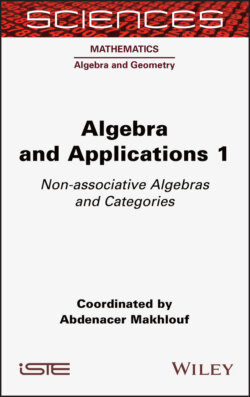Читать книгу Algebra and Applications 1 - Abdenacer Makhlouf - Страница 30
2.2.2. Rotations in three- (and four-) dimensional space
ОглавлениеGiven a norm 1 quaternion q, there is an angle α ∈ [0, π] and a norm 1 imaginary quaternion u such that q = (cos α)1 + (sin α)u.
Consider the linear map:
Complete u to an orthonormal basis {u, v, u × v}. A simple computation gives:
Thus, the coordinate matrix of φq relative to the basis {u, v, u × v} is
In other words, φq is a rotation around the semi-axis ℝ+u of angle 2α, and hence the map
is a surjective (Lie) group homomorphism with ker φ = {±1}. We thus obtain the isomorphism
Actually, the group S3 is the universal cover of SO3(ℝ).
Therefore, we get that rotations can be identified with conjugation by norm 1 quaternions modulo ±1. The outcome is that it is quite easy now to compose rotations in three-dimensional Euclidean space, as it is enough to multiply norm 1 quaternions: φp φq = φpq. From this, one can very easily deduce the 1840 formulas by Olinde Rodrigues (Rodrigues 1840) for the composition of rotations.
But there is more about rotations and quaternions.
For any p ∈ ℍ with n(p) = 1, the left (respectively, right) multiplication Lp (respectively, Rp) by p is an isometry, due to the multiplicativity of the norm. Using [2.2], it follows that the characteristic polynomial of Lp and Rp is x2 − tr(p)x +1)2 and, in particular, the determinant of the multiplication by p is 1, so both Lp and Rp are rotations.
Now, if ψ is a rotation in ℝ4 ≃ ℍ, a = ψ(1) is a norm 1 quaternion, and
so the composition is actually a rotation in ℝ3 ≃ ℍ0. Hence, there is a norm 1 quaternion q ∈ ℍ such that
for any x ∈ ℍ. That is, for any x ∈ ℍ,
It follows that the map
is a surjective (Lie) group homomorphism with ker Ψ = {±(1, 1)}. We thus obtain the isomorphism
and from here we get the isomorphism SO3 (ℝ) × SO3 (ℝ) ≃ PSO4 (ℝ).
Again, this means that it is easy to compose rotations in four-dimensional space, as it reduces to multiplying pairs of norm 1 quaternions: ψp1, q1 ψp2, q2 = ψp1p2, q1q2.
